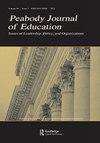St. Louis at the Crossroads of Race, Empire, and Place in Urban Education Reform in the United States
Q2 Social Sciences
引用次数: 0
Abstract
Researchers are increasingly paying closer attention to the geography of educational opportunity, particularly the role of race and place in shaping people’s educational experiences and outcomes (Diamond et al., 2021; Morris & Monroe, 2009; Morris & Woodruff, 2015; Posey-Maddox, 2017; Tate, 2008). The city of St. Louis—known for being a northern city with Southern culture—provides a significant, symbolic but often overlooked context (place) for understanding and examining urban education reform in the United States. I first came to know the city in the mid-late 1990s when I traveled between Nashville, Tennessee, and St. Louis, Missouri, to work as a graduate assistant on a research project led by highly regarded scholars Ellen Goldring and Claire Smrekar of Peabody College at Vanderbilt University. Professors Goldring and Smrekar had received funding from the Spencer Foundation to understand school choice, particularly magnet schools, in three different cities, one of which included St. Louis (Goldring & Smrekar, 2000; Smrekar & Goldring, 1999). While carving out my niche on the research project and eventually a dissertation topic, I was particularly intrigued by one Black school community in St. Louis —Farragut Elementary School located in the historic Ville neighborhood. Beyond Farragut’s shiny hardwood floors and immaculate hallways, I was in awe of the sense of pride the school’s staff created with the community and the powerful relationships forged over decades among the mostly Black teachers, students, and families. Farragut Elementary School embodied elements of the kind of schoolcommunity that led to academic excellence that Black people experienced in the segregated South (Anderson, 1988; Jones, 1981; Savage, 1998; Siddle Walker, 1996, 2000). Quite often, the narrative related to Black schooling during that time, and even today, painted a sordid picture of Black K-12 educational institutions. Farragut’s faculty, staff, students, and their parents’ experiences and outcomes; however, countered this pervasive perspective. Yet, few researchers studied academically highperforming schools like Farragut and its intrinsic presence of what I would later come to define as communally bonded schooling (Morris, 1999, 2004, 2009). Between 1997 and 2015—while working as a professor at the University of Georgia and researching a school community in Atlanta, Georgia, that also displayed communally bonded schooling—I stayed abreast of Farragut Elementary School in St. Louis. I periodically visited the school and paid attention to the changes in the school that would begin to unravel what I had captured in an American Educational Research Journal article “Can Anything Good Come from Nazareth? African American schooling and community in the Urban South and Midwest” (Morris, 2004). Though not exhaustive, some of Farragut’s changes included the principal’s death, the retirement of Black teachers and the hiring of Teach for America teachers, the growth of charter schools, and the lack of investment in the community surrounding the school. Once considered an exemplary school on almost every measure of achievement, Farragut Elementary School had quickly become a shell of its former self. The school was closed in 2021 by district administrators due to purported low student enrollment, underachievement, and fiscal concerns (Morris, 2021).美国城市教育改革中处于种族、帝国和地位十字路口的圣路易斯
研究人员越来越关注教育机会的地理位置,特别是种族和地点在塑造人们的教育体验和结果中的作用(Diamond et al.,2021;莫里斯和门罗,2009年;莫里斯和伍德拉夫,2015;Posey Maddox,2017;泰特,2008年)。圣路易斯市以具有南方文化的北方城市而闻名,它为理解和审视美国的城市教育改革提供了一个重要的、象征性的但经常被忽视的背景(场所)。我第一次了解这座城市是在20世纪90年代中后期,当时我往返于田纳西州的纳什维尔和密苏里州的圣路易斯,在范德比尔特大学皮博迪学院的知名学者Ellen Goldring和Claire Smrekar领导的一个研究项目中担任研究生助理。Goldring和Smrekar教授获得了Spencer基金会的资助,以了解三个不同城市的学校选择,特别是吸引人的学校,其中一个城市包括圣路易斯(Goldring&Smrekar,2000;Smrekar&Goldring,1999)。在研究项目并最终成为论文主题的过程中,我对圣路易斯的一个黑人学校社区特别感兴趣——位于历史悠久的维尔社区的法拉古特小学。除了法拉古特闪亮的硬木地板和整洁的走廊外,我对学校工作人员与社区建立的自豪感以及几十年来在以黑人为主的教师、学生和家庭之间建立的强大关系感到敬畏。Farragut小学体现了黑人在种族隔离的南方所经历的那种学校社区的元素,这种社区导致了黑人在学术上的卓越表现(Anderson,1988;Jones,1981;Savage,1998;Siddle Walker,19962000)。在那段时间,甚至今天,与黑人学校教育有关的叙事往往描绘了黑人K-12教育机构的肮脏画面。Farragut的教职员工、学生及其父母的经历和成果;然而,他反驳了这种普遍存在的观点。然而,很少有研究人员研究像Farragut这样学业成绩优异的学校,以及它的内在存在,我后来将其定义为社区纽带学校(Morris,199920042009)。1997年至2015年间,我在佐治亚大学担任教授,研究佐治亚州亚特兰大的一个学校社区,该社区也展示了社区纽带教育,我了解圣路易斯的法拉古特小学。我定期访问这所学校,关注学校的变化,这些变化将开始解开我在《美国教育研究杂志》的一篇文章《拿撒勒有什么好东西吗?南部和中西部城市的非裔美国人教育和社区》(Morris,2004)中所捕捉到的。尽管并非详尽无遗,但Farragut的一些变化包括校长去世、黑人教师退休和聘请“为美国教学”教师、特许学校的发展以及对学校周围社区缺乏投资。法拉古特小学曾经被认为是一所几乎在所有成就方面都堪称典范的学校,但很快就变成了以前的样子。由于据称学生入学率低、成绩不佳和财政问题,该校于2021年被地区管理人员关闭(Morris,2021)。
本文章由计算机程序翻译,如有差异,请以英文原文为准。
求助全文
约1分钟内获得全文
求助全文
来源期刊

Peabody Journal of Education
Social Sciences-Education
CiteScore
2.20
自引率
0.00%
发文量
43
期刊介绍:
Peabody Journal of Education (PJE) publishes quarterly symposia in the broad area of education, including but not limited to topics related to formal institutions serving students in early childhood, pre-school, primary, elementary, intermediate, secondary, post-secondary, and tertiary education. The scope of the journal includes special kinds of educational institutions, such as those providing vocational training or the schooling for students with disabilities. PJE also welcomes manuscript submissions that concentrate on informal education dynamics, those outside the immediate framework of institutions, and education matters that are important to nations outside the United States.
 求助内容:
求助内容: 应助结果提醒方式:
应助结果提醒方式:


